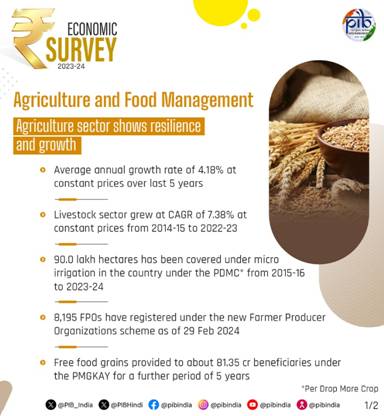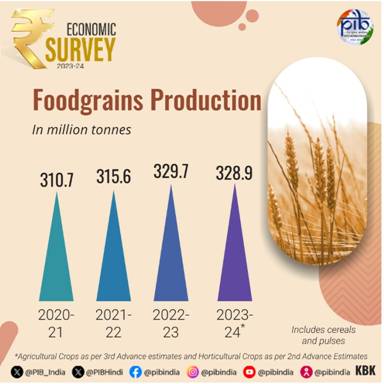Ministry of Finance
AGRICULTURE SECTOR HAS REGISTERED AN AVERAGE ANNUAL GROWTH RATE OF 4.18 PER CENT OVER THE LAST FIVE YEARS : ECONOMIC SURVEY
SMALLHOLDER FARMERS NEED TO MOVE TO HIGH-VALUE
AGRICULTURE
TOTAL AREA COVERAGE OF ALL OILSEEDS HAS INCREASED FROM 25.60 MILLION HECTARES IN 2014-15 TO 30.08 MILLION HECTARES IN 2023-24(17.5 PERCENT GROWTH)
ENHANCING PRIVATE SECTOR INVESTMENT IN AGRICULTURE IS VITAL TO PROVIDING IMPETUS TO THE SECTOR
प्रविष्टि तिथि:
22 JUL 2024 2:59PM by PIB Delhi
Economic Survey 2023-24 presented in the Parliament today by Union Finance and Corporate Affairs Minister Smt. Nirmala Sitharaman. Economic Survey says that smallholder farmers need to move to high-value agriculture. The Survey says once the incomes of smallholders increases, they will demand manufactured goods, spurring a manufacturing revolution.

Economic Survey says that the Indian agriculture sector provides livelihood support to about 42.3 per cent of the population and has a share of 18.2 per cent in the country’s GDP at current prices. The sector has been buoyant, which is evident from the fact that it has registered an average annual growth rate of 4.18 per cent at constant prices over the last five years and as as per provisional estimates for 2023-24, the growth rate of the agriculture sector stood at 1.4 percent.
Economic Survey states that the Investment in agriculture research and support of enabling policies have contributed substantially to food security. It is estimated that for every rupee invested in agricultural research (including education), there is a payoff of ₹13.85. In 2022-23, ₹19.65 Thousand Crore was spent on agriculture research.
Economic Survey calls for enhancing private sector investment in agriculture saying it is vital to provide impetus to the agriculture sector. Investment in technology, production methods, marketing infrastructure, and reduction in post-harvest losses need to be scaled up. A greater focus on post-harvest infrastructure and the development of the food processing sector can reduce wastage/loss and increase the length of storage, ensuring better prices for the farmers.

Economic Survey says that in 2022-23, foodgrain production hit an all-time high of 329.7 million tonnes, and oilseeds production reached 41.4 million tonnes. In 2023-24, food grain production is slightly lower at 328.8 million tonnes, primarily because of poor and delayed monsoons. The domestic availability of edible oil has risen from 86.30 lakh tonnes in 2015-16 to 121.33 lakh tonnes in 2023-24. The total area coverage of all oilseeds has increased from 25.60 million hectares in 2014-15 to 30.08 million hectares in 2023-24(17.5 percent growth). This has reduced the percentage share of imported edible oil, from 63.2 per cent in 2015-16 to 57.3 percent in 2022-23, despite rising domestic demand and consumption patterns.
Economic Survey suggests that to promote efficiency in agriculture marketing, and improve price discovery, the government implemented the e-NAM Scheme and as of 14th March 2024, more than 1.77 Crore farmers and 2.56 Lakh traders have been registered on the e-NAM portal. The Government of India launched the scheme to form and promote 10,000 FPOs in 2020 with a budget outlay of ₹6.86 thousand crore till 2027-28. As of 29 February 2024, 8,195 FPOs have registered under the new FPO scheme, and equity grants of ₹157.4 crore were released to 3,325 FPOs. Credit guarantee cover worth ₹278.2 crore was issued to 1,185 FPOs.
Economic Survey states that the Agricultural price support assures farmers of remunerative returns, increasing income and allows the Government to ensure a stable supply of staples at reasonable prices. Accordingly, the Government has been increasing the MSP for all Kharif, Rabi and other commercial crops with a margin of at least 50 per cent over the all-India weighted average cost of production since the agricultural year 2018-19.
Economic Survey shows that to provide social security to the most vulnerable farmer families, the Government implements Pradhan Mantri Kisan Maandhan Yojna (PMKMY). The scheme offers a monthly pension of ₹3,000 to the enrolled farmers on the attainment of 60 years of age, based on a nominal premium between ₹55 to ₹200 per month paid by the applicant (in the age group 18 to 40 years) subject to exclusion criteria. As of 07 July 2024, 23.41 lakh farmers have enrolled under the scheme.
Economic Survey, on focusing to reduce the use of chemical fertilizer, states that the PM Programme for Restoration, Awareness Generation, Nourishment, and amelioration of Mother Earth (PM-PRANAM ) initiative incentivises states to reduce chemical fertiliser use. It promotes sustainable methods such as the use of alternative fertilisers, viz. Nano Urea, Nano DAP, and organic fertiliser.
Focusing on the security of farmers’ crop, Economic Survey highlighted the Pradhan Mantri Fasal Bima Yojana (PMFBY) which offer a safety net against crop losses due to natural calamities, pests, or diseases, ensuring financial stability for farmers. The scheme safeguards farmers’ livelihoods and encourage them to adopt modern farming practices and technologies. PMFBY is the largest crop insurance scheme in the world in terms of farmer enrolment and is the third largest scheme in terms of insurance premiums. The scheme ensure comprehensive risk cover for crops to farmers against all non-preventable natural risks from pre-sowing to post-harvest. The overall insured area in 2023-24 reached 610 lakh ha compared to 500.2 lakh ha in 2022-23. A total of 5549.40 Lakh farmer applications were insured under the scheme since 2016-17, and ₹150589.10 Crore has been paid as claims.
***
NB/SK/SS
(रिलीज़ आईडी: 2034943)
आगंतुक पटल : 47221
इस विज्ञप्ति को इन भाषाओं में पढ़ें:
Urdu
,
हिन्दी
,
Hindi_MP
,
Marathi
,
Assamese
,
Punjabi
,
Gujarati
,
Odia
,
Tamil
,
Telugu
,
Kannada
,
Malayalam